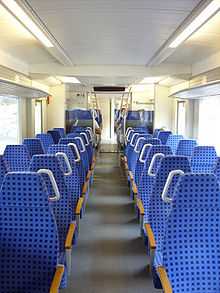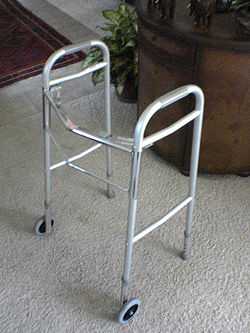Falls in older adults
Falls in older adults are a significant cause of morbidity and mortality. The cause is often multi-factorial, and may require a multi-disciplinary approach both to treat any injuries sustained and to prevent future falls.[1] Falls include dropping from a standing position, or from exposed positions such as those on ladders or stepladders. The severity of injury is generally related to the height of the fall. The state of the ground surface onto which the victim falls is also important, harder surfaces causing more severe injury.
Definition
The unintentionally dropping onto the ground or lower level, not as a result of a major intrinsic event (such as a stroke) or overwhelming hazard.”[2] Other definitions are more inclusive and do not exclude "major intrinsic events" as a fall.[3] Such falls are clearly of accidental origin, which might include a large number of causes, such as slips, trips and over-balancing.
Falls are an important aspect of geriatric medicine.
Signs and symptoms
- Trauma
- Soft tissue injuries. Bilateral orbital haematomas (two black eyes) suggests that the faller was probably not conscious as they fell, as they did not manage to protect their face as they hit the ground.
- Fractures and dislocations. 5% of fallers end up having a fracture as a result of their fall, and 1% fracture their neck of femur.
- Disuse atrophy and muscle wasting from reduced physical activity during recovery periods
- Due to bed rest
- Pneumonia
- Pressure sores
- Dehydration
- Hypothermia
- A fear of falling[4]
Causes
Falls are often caused by a number of factors. The faller may live with many risk factors for falling and only have problems when another factor appears. As such, management is often tailored to treating the factor that caused the fall, rather than all of the risk factors a patient has for falling. Risk factors may be grouped into intrinsic factors, such as existence of a specific ailment or disease. External or extrinsic factors includes the environment and the way in which it may encourage or deter accidental falls. Such factors as lighting and illumination, personal aid equipment and floor traction are all important in fall prevention.[4]
Intrinsic factors
- Balance and Gait
- As a result of stroke disease, Parkinsonism, arthritic changes, neuropathy, neuromuscular disease or vestibular disease.
- Visual and Motor Reaction Time Problems
- An extended reaction time will delay responses and compensations to standing or walking imbalances, thus increasing the likelihood of falls.
- Medications
- Polypharmacy is common in older people
- Sedatives significantly increase the risk of falling
- Cardiovascular medications can contribute towards falls
- Visual impairment
- Glaucoma, macular degeneration and retinopathy increase the risk of falling
- Bifocals and trifocals can increase the risk of falling as the lower portion of corrective lenses are optimized for distances approximately 18 inches, thus precluding clear vision of one's feet/floor, approximately 4.5 to 5.5 feet below one's eyes.
- Cognitive problems
- Dementia increases the likelihood of falls
- Cardiovascular causes
- Orthostatic hypotension
- Postprandial hypotension
- Carotid sinus syndrome
- Neurocardiogenic syncope – the commonest cause of syncope in A&E patients
- Cardiac arrhythmias
- Structural heart disease, such as valvular heart disease
- Urinary incontinence
Extrinsic factors



- Poor lighting due to low luminance of existing lights or lamps, so preventing hazard identification and avoidance. Eyesight deteriorates with age, and extra lighting will be needed where seniors move frequently. The power of the bulbs used should be higher than normally accepted, with incandescent bulbs preferred.
- Stairs with inadequate handrails, or too steep, encouraging trips and falls. The steps should be spaced widely with low risers, and surfaces should be slip-resistant. Softer surfaces can help limit impact injuries by cushioning loads.
- Rugs/floor surfaces with low friction, causing poor traction and individual instability. All surfaces should have a high friction coefficient with shoe soles.
- Clothing/footwear poorly fitted, shoes of low friction against floor. Rubber soles with ribs normally have a high friction coefficient, so are preferred for most purposes. Clothing should fit the user well, without trailing parts (hems falling below the heel and loose shoe strings) which could snag with obstacles
- Lack of equipment/aids such as walking sticks or walking frames, such as Zimmer frames so as to improve user stability. Grab bars and hanging straps should be supplied plentifully, especially in critical areas where users may be vulnerable.
Diagnosis
When assessing a person who has fallen, it is important to try to get an eyewitness account of the incident. As the faller may have had some loss of consciousness, they may not give an accurate description of the fall. However, in practice, these eyewitness accounts are often unavailable. It is also important to remember than 30% of cognitively intact older people are unable to remember a documented fall three months later. Important points of inquiry:
- Visual motor reaction time
- Frequency of falls
- Effectiveness of "parachute" corrective response of moving hand and arm to "break" the fall
- Eyewitness account
- Associated features
- Risk factors for falling
- legal and illegal drug interactions
- Sedative and alcohol consumption
- Assessment of proper, safe use of cane or walker assistive device
It is good practice to exclude anaemia, renal failure, and electrolyte imbalance, and to perform an ECG and a chest x-ray. Other tests should be tailored to the cause of the fall.
Prevention
A large body of evidence shows that a multi-disciplinary approach to assessment and treatment results in the best outcome.[5][6][7]
Possible interventions include:
- Provision of safety devices such as grab handles,
high friction floors and footwear, as well as high power lighting
- Hip protectors
- Regular exercise
- Treatment for osteoporosis
- Review – monitoring of medications and ongoing medical problems
- Tackling environmental issues, including a review of current living conditions (action checklist)
Screening
American Geriatrics society (AGS)/British Geriatrics Society (BGS) recommend that all older adults should be screened for "falls in the past year". Fall history is the strongest risk factor associated with subsequent falls.[8]
Many health institutions in USA have developed screening questionnaires. Enquiry includes difficulty with walking and balance, medication use to help with sleep/mood, loss of sensation in feet, vision problems, fear of falling, and use of assistive devices for walking.
Older adults who reports falls should be asked about the circumstances and frequency. They should have an assessment of gait and balance. Older persons who present for medical attention because of a fall, or who report recurrent falls in the past, fail the gait & balance test, or report difficulties in walking & balance should have a multifactorial fall risk assessment. A multifactorial fall risk assessment is done by a clinician and includes focused history, physical exam, functional assessment and environment assessment.[9]
Epidemiology
Every year, the following proportion of people suffer from a fall:
| >65 years | >75 years | Institutional Care | Recurrent Fallers | Healthy Elderly |
|---|---|---|---|---|
| 28–35% | 32–45% | >50% | 60–70% | 15% |
Falls are the most common report given by patients over the age of 65 to emergency departments.
Economics
The health care impact and costs of falls in older adults is significantly rising all over the world. The cost of falls are categorized into 2 aspects: direct cost and indirect cost.
Direct costs are what patients and insurance companies pay for treating fall-related injuries. This includes fees for hospital and nursing home, doctors and other professional services, rehabilitation, community-based services, use of medical equipment, prescription drugs, changes made to home and insurance processing.
Indirect costs include the loss of productivity of family caregivers and long-term effects of fall-related injuries such as disability, dependence on others and reduced quality of life.
In US alone, the total cost of fall injuries for people 65 and older was $30 billion in 2012. The cost covered 2.4 millions ER visits for non fatal injuries and more than 722,000 hospitalizations. By 2020, the annual direct and indirect cost of fall injuries is expected to reach $67.7 billion.[10]
Research
A fall occurs when a person's centre of mass goes outside of the base of support. A majority of research on postural instability has focused on the anterior/posterior directions due to the structure of the legs and the frequency of falls in those directions. Maki, Holliday, & Topper (1994) has stated that sway in the medial/lateral directions can be just as important, “Results show strong evidence linking deficits in postural balance related to the control of the m–l stability with an increased risk of falling”.[11] The mechanisms of postural instability are not fully understood, but research has suggested that disorders affecting sensory input and efferent motor signals are the primary causes.
Furthermore, a recent systematic review has demonstrated that performing dual-task tests (for example, combining a walking task with a counting task) may help in predicting which people are at an increased risk of a fall.[1]
References
- ↑ 1.0 1.1 Sarofim M (2012). "Predicting falls in the elderly: do dual-task tests offer any added value? A systematic review". AMSJ 3 (2): 13–19.
- ↑ Tinetti ME, Speechley M, Ginter SF (Dec 1988). "Risk factors for falls among elderly persons living in the community". N Engl J Med. 319 (26): 1701–7. doi:10.1056/NEJM198812293192604. PMID 3205267.
- ↑ http://www.ncbi.nlm.nih.gov/books/NBK2653/
- ↑ 4.0 4.1 4.2 Department of Health, National service framework for older people; Standard 6 – Falls, Crown Copyright, 24 May 2001, accessed:19/5/2008
- ↑ Tinetti, ME; Baker DI; Garrett PA; Gottschalk M; Koch ML; Horwitz RI (March 1993). "Yale FICSIT: risk factor abatement strategy for fall prevention". J Am Geriatr Soc 41 (3): 315–20. PMID 8440856.
- ↑ Tinetti, ME; Baker DI; McAvay G; Claus EB; Garrett P; Gottschalk M; Koch ML; Trainor K; Horwitz RI. (September 1994). "A multifactorial intervention to reduce the risk of falling among elderly people living in the community". N Engl J Med. 331 (13): 821–7. doi:10.1056/NEJM199409293311301. PMID 8078528. Retrieved 2008-05-19.
- ↑ Close, J; Ellis M; Hooper R; Glucksman E; Jackson S; Swift C. (January 1999). "Prevention of falls in the elderly trial (PROFET): a randomised controlled trial". Lancet 353 (9147): 93–7. doi:10.1016/S0140-6736(98)06119-4. PMID 10023893.
- ↑ DK, Kiely (1998). "IDENTIFYING NURSING HOME RESIDENTS AT RISK OF FALLING". Journal of American Geriatrics society 46 (5): 551–555. PMID 9588366.
- ↑ http://www.americangeriatrics.org/health_care_professionals/clinical_practice/clinical_guidelines_recommendations/prevention_of_falls_summary_of_recommendations. Missing or empty
|title=(help) - ↑ http://www.cdc.gov/HomeandRecreationalSafety/Falls/fallcost.html. Missing or empty
|title=(help) - ↑ Maki, B. E., Holliday, P. J., & Topper, A.K. (1994). A prospective study of postural balance and risk of falling in an ambulatory and independent elderly population, Journal of Gerontology, 49(2), M72-M84.
External links
- Falls Among Older Adults: Brochures and Posters (in English, Spanish, and Chinese) US Centers for Disease Control and Prevention
- Falls Among Older Adults: An Overview US Centers for Disease Control and Prevention
- Costs of Falls Among Older Adults US Centers for Disease Control and Prevention
- Hip Fractures Among Older Adults US Centers for Disease Control and Prevention
- Falls in Nursing Homes US Centers for Disease Control and Prevention
- CDC Fall Prevention Activities US Centers for Disease Control and Prevention
- Preventing Falls: What Works―A CDC Compendium of Effective Community-based Interventions from Around the World US Centers for Disease Control and Prevention
- Preventing Falls: How to Develop Community-based Fall Prevention Programs for Older Adults US Centers for Disease Control and Prevention
- Public Health Grand Rounds: Help Older Adults Live Better, Longer: Prevent Falls and Traumatic Brain Injuries US Centers for Disease Control and Prevention
- CDC’s Division of Unintentional Injury – Podcasts US Centers for Disease Control and Prevention